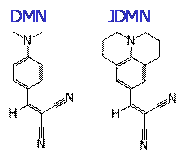Reports: AC6
46140-AC6 Modeling Spectroscopic Measurements of Solvation and Solvent Friction
Two unrelated computational projects were proposed for this 2-year grant. The first project involved molecular dynamics simulations of solvation, solvation dynamics, and solvatochromism in gas-expanded liquids (GXLs). The work was completed prior to the last yearly report, and 2 papers describing this work are now published.
The
second project involves modeling the isomerization dynamics of malononitriles. Motivation for this work was explained in the
previous progress report. Over the past
year, we have undertaken extensive
 experimental
studies to characterize two such molecules, DMN and JDMN, shown at the left. This experimental work was supported by
DOE. PRF support was used to perform
parallel computational studies on these two molecules (and related species). We have calculated properties of the ground
electronic states of DMN and JDMN molecules using various levels of theory such
as B3LYP, LC-B3LYP, and RI-CC2 with good quality triple zeta basis sets and
compared predicted structures and electronic properties with experimental values. We found that no single method provides completely
accurate predictions for all properties, in particular the dipole moments of
these molecules are over-estimated, but all ground-state predictions are reasonable. Calculations of the S0 ® S1
transition were also calculated using these methods. Whereas all methods provided surprisingly
accurate predictions of their gas-phase transition frequencies, TD-B3LYP
calculations badly underestimated the changes in dipole moment they undergo upon
electronic excitation. Long-range
corrections were did not correct this deficiency of the DFT method. We explored the excited-state potential
surface using TD-B3LYP, RI-CC2, and SA2-CASSCF calculations. These calculations revealed the deactivation
mechanism to be a double-bond isomerization that leads to a conical intersection
between S1 and S0.
Using the best S1 potential surfaces we generated, we then performed
classical molecular dynamics simulations of the S1 isomerization of
DMN in acetonitrile solution. Time-resolved
spectra calculated from these simulations showed that the time scale for this
process was close to the ~1 ps fluorescence lifetime observed experimentally
for this system. These simulations
therefore helped validate the proposed isomerization mechanism of internal
conversion. A paper reporting this work is
currently under revision. We intend to
continue computational work in order to refine our understanding of these
systems, in particular using simulations to help explain the environmental
sensitivity of these molecular rotor probes.
experimental
studies to characterize two such molecules, DMN and JDMN, shown at the left. This experimental work was supported by
DOE. PRF support was used to perform
parallel computational studies on these two molecules (and related species). We have calculated properties of the ground
electronic states of DMN and JDMN molecules using various levels of theory such
as B3LYP, LC-B3LYP, and RI-CC2 with good quality triple zeta basis sets and
compared predicted structures and electronic properties with experimental values. We found that no single method provides completely
accurate predictions for all properties, in particular the dipole moments of
these molecules are over-estimated, but all ground-state predictions are reasonable. Calculations of the S0 ® S1
transition were also calculated using these methods. Whereas all methods provided surprisingly
accurate predictions of their gas-phase transition frequencies, TD-B3LYP
calculations badly underestimated the changes in dipole moment they undergo upon
electronic excitation. Long-range
corrections were did not correct this deficiency of the DFT method. We explored the excited-state potential
surface using TD-B3LYP, RI-CC2, and SA2-CASSCF calculations. These calculations revealed the deactivation
mechanism to be a double-bond isomerization that leads to a conical intersection
between S1 and S0.
Using the best S1 potential surfaces we generated, we then performed
classical molecular dynamics simulations of the S1 isomerization of
DMN in acetonitrile solution. Time-resolved
spectra calculated from these simulations showed that the time scale for this
process was close to the ~1 ps fluorescence lifetime observed experimentally
for this system. These simulations
therefore helped validate the proposed isomerization mechanism of internal
conversion. A paper reporting this work is
currently under revision. We intend to
continue computational work in order to refine our understanding of these
systems, in particular using simulations to help explain the environmental
sensitivity of these molecular rotor probes.




